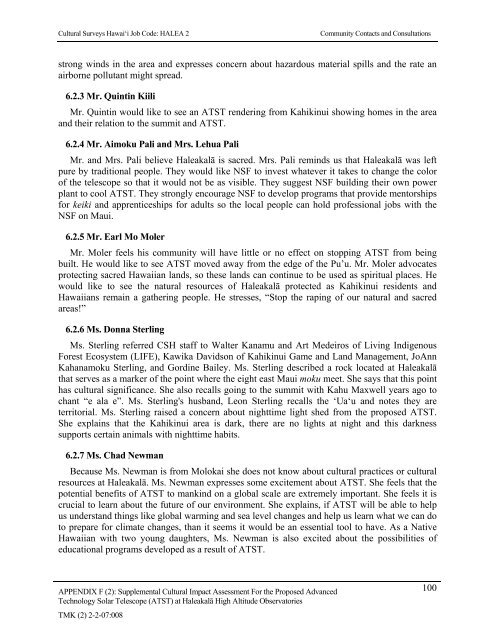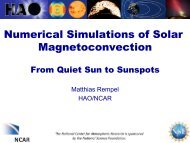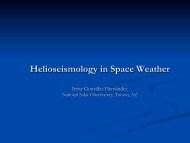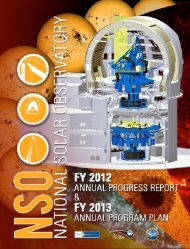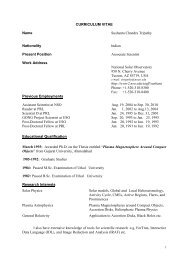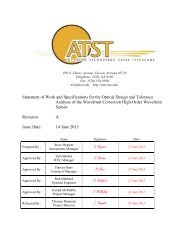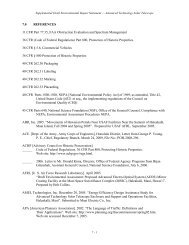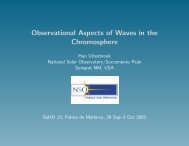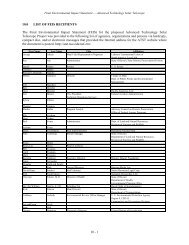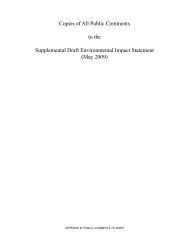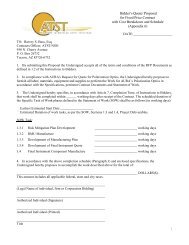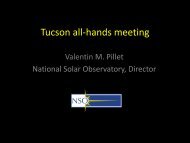F2 - ATST
F2 - ATST
F2 - ATST
Create successful ePaper yourself
Turn your PDF publications into a flip-book with our unique Google optimized e-Paper software.
Cultural Surveys Hawai‘i Job Code: HALEA 2Community Contacts and Consultationsstrong winds in the area and expresses concern about hazardous material spills and the rate anairborne pollutant might spread.6.2.3 Mr. Quintin KiiliMr. Quintin would like to see an <strong>ATST</strong> rendering from Kahikinui showing homes in the areaand their relation to the summit and <strong>ATST</strong>.6.2.4 Mr. Aimoku Pali and Mrs. Lehua PaliMr. and Mrs. Pali believe Haleakalā is sacred. Mrs. Pali reminds us that Haleakalā was leftpure by traditional people. They would like NSF to invest whatever it takes to change the colorof the telescope so that it would not be as visible. They suggest NSF building their own powerplant to cool <strong>ATST</strong>. They strongly encourage NSF to develop programs that provide mentorshipsfor keiki and apprenticeships for adults so the local people can hold professional jobs with theNSF on Maui.6.2.5 Mr. Earl Mo MolerMr. Moler feels his community will have little or no effect on stopping <strong>ATST</strong> from beingbuilt. He would like to see <strong>ATST</strong> moved away from the edge of the Pu’u. Mr. Moler advocatesprotecting sacred Hawaiian lands, so these lands can continue to be used as spiritual places. Hewould like to see the natural resources of Haleakalā protected as Kahikinui residents andHawaiians remain a gathering people. He stresses, “Stop the raping of our natural and sacredareas!”6.2.6 Ms. Donna SterlingMs. Sterling referred CSH staff to Walter Kanamu and Art Medeiros of Living IndigenousForest Ecosystem (LIFE), Kawika Davidson of Kahikinui Game and Land Management, JoAnnKahanamoku Sterling, and Gordine Bailey. Ms. Sterling described a rock located at Haleakalāthat serves as a marker of the point where the eight east Maui moku meet. She says that this pointhas cultural significance. She also recalls going to the summit with Kahu Maxwell years ago tochant “e ala e”. Ms. Sterling's husband, Leon Sterling recalls the ‘Ua‘u and notes they areterritorial. Ms. Sterling raised a concern about nighttime light shed from the proposed <strong>ATST</strong>.She explains that the Kahikinui area is dark, there are no lights at night and this darknesssupports certain animals with nighttime habits.6.2.7 Ms. Chad NewmanBecause Ms. Newman is from Molokai she does not know about cultural practices or culturalresources at Haleakalā. Ms. Newman expresses some excitement about <strong>ATST</strong>. She feels that thepotential benefits of <strong>ATST</strong> to mankind on a global scale are extremely important. She feels it iscrucial to learn about the future of our environment. She explains, if <strong>ATST</strong> will be able to helpus understand things like global warming and sea level changes and help us learn what we can doto prepare for climate changes, than it seems it would be an essential tool to have. As a NativeHawaiian with two young daughters, Ms. Newman is also excited about the possibilities ofeducational programs developed as a result of <strong>ATST</strong>.APPENDIX F (2): Supplemental Cultural Impact Assessment For the Proposed AdvancedTechnology Solar Telescope (<strong>ATST</strong>) at Haleakalā High Altitude ObservatoriesTMK (2) 2-2-07:008100


